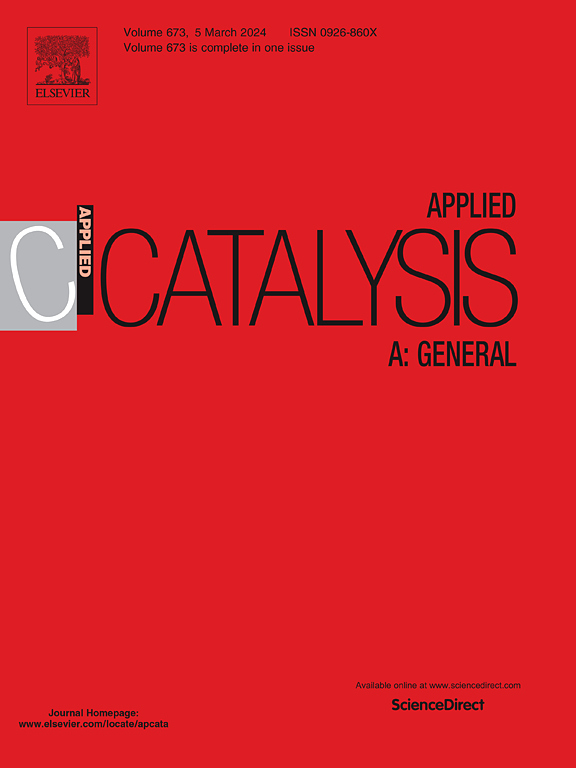Insights into the mechanism of plasma pretreatment-enhanced ammonia decomposition kinetics from a lattice-mediated perspective
IF 4.8
2区 化学
Q2 CHEMISTRY, PHYSICAL
引用次数: 0
Abstract
Fe, Co, Ni and other transition metal-based catalysts are widely applied in the catalysis field due to their unique d-orbital electronic configurations. However, transition metal/oxide catalysts face challenges such as metal particle aggregation and insufficient intrinsic activity during thermocatalytic ammonia decomposition reaction (ADR), which significantly limits their practical applications. Herein, we propose a high-energy ammonia plasma pretreatment strategy to disperse aggregated metal particles and introduce nitrogen-containing intermediates (such as NH and NH2) into the catalyst lattice. This approach is designed to increase the exposure of active sites and regulate the dehydrogenation and N![]() N recombination pathways in the ADR via NHx groups within the catalyst. The regulation method introduced NH and NH2 intermediates, significantly enhancing the catalyst's ammonia decomposition performance. Results demonstrated that at 650℃ under a gas hourly space velocity (GHSV) of 9552 h−1, the ammonia plasma-pretreated catalyst (Ni/Al2O3-PT) exhibited an 11 % higher conversion rate compared to the untreated Ni/Al2O3 achieving a hydrogen production rate of 6.59 mmol·g−1cat·min−1 (versus 5.97 mmol·g−1cat·min−1 for Ni/Al2O3). When the GHSV was increased to 19104 h−1 at 550℃, Ni/Al2O3-PT showed a 16 % higher conversion rate than Ni/Al2O3. Long-term stability tests conducted over 50 h confirmed the excellent operational stability of the Ni/Al2O3-PT catalyst. Our work presented an efficient solution to the challenges of transition metal-based catalysts while providing a theoretical framework for novel catalyst design through a lattice-mediated intermediate evolution model.
N recombination pathways in the ADR via NHx groups within the catalyst. The regulation method introduced NH and NH2 intermediates, significantly enhancing the catalyst's ammonia decomposition performance. Results demonstrated that at 650℃ under a gas hourly space velocity (GHSV) of 9552 h−1, the ammonia plasma-pretreated catalyst (Ni/Al2O3-PT) exhibited an 11 % higher conversion rate compared to the untreated Ni/Al2O3 achieving a hydrogen production rate of 6.59 mmol·g−1cat·min−1 (versus 5.97 mmol·g−1cat·min−1 for Ni/Al2O3). When the GHSV was increased to 19104 h−1 at 550℃, Ni/Al2O3-PT showed a 16 % higher conversion rate than Ni/Al2O3. Long-term stability tests conducted over 50 h confirmed the excellent operational stability of the Ni/Al2O3-PT catalyst. Our work presented an efficient solution to the challenges of transition metal-based catalysts while providing a theoretical framework for novel catalyst design through a lattice-mediated intermediate evolution model.
从晶格介导的角度深入了解等离子体预处理增强氨分解动力学的机制
Fe、Co、Ni等过渡金属基催化剂因其独特的d轨道电子构型而广泛应用于催化领域。然而,过渡金属/氧化物催化剂在热催化氨分解反应(ADR)中存在金属颗粒聚集和固有活性不足等问题,极大地限制了其实际应用。在此,我们提出了一种高能氨等离子体预处理策略,以分散聚集的金属颗粒,并将含氮中间体(如nhh和NH2)引入催化剂晶格。这种方法旨在增加活性位点的暴露,并通过催化剂中的NHx基团调节ADR中的脱氢和NN重组途径。调节方法引入了nhh和NH2中间体,显著提高了催化剂的氨分解性能。结果表明,在650℃、气时空速(GHSV)为9552 h−1的条件下,经氨等离子体预处理的Ni/Al2O3- pt催化剂的产氢率为6.59 mmol·g−1cat·min−1 (Ni/Al2O3为5.97 mmol·g−1cat·min−1),比未处理的Ni/Al2O3催化剂的转化率高11 %。当GHSV在550℃下增加到19104 h−1时,Ni/Al2O3- pt的转化率比Ni/Al2O3高16 %。在50 h以上进行的长期稳定性测试证实了Ni/Al2O3-PT催化剂具有优异的操作稳定性。我们的工作为过渡金属基催化剂的挑战提供了有效的解决方案,同时通过晶格介导的中间演化模型为新型催化剂的设计提供了理论框架。
本文章由计算机程序翻译,如有差异,请以英文原文为准。
求助全文
约1分钟内获得全文
求助全文
来源期刊

Applied Catalysis A: General
化学-环境科学
CiteScore
9.00
自引率
5.50%
发文量
415
审稿时长
24 days
期刊介绍:
Applied Catalysis A: General publishes original papers on all aspects of catalysis of basic and practical interest to chemical scientists in both industrial and academic fields, with an emphasis onnew understanding of catalysts and catalytic reactions, new catalytic materials, new techniques, and new processes, especially those that have potential practical implications.
Papers that report results of a thorough study or optimization of systems or processes that are well understood, widely studied, or minor variations of known ones are discouraged. Authors should include statements in a separate section "Justification for Publication" of how the manuscript fits the scope of the journal in the cover letter to the editors. Submissions without such justification will be rejected without review.
 求助内容:
求助内容: 应助结果提醒方式:
应助结果提醒方式:


